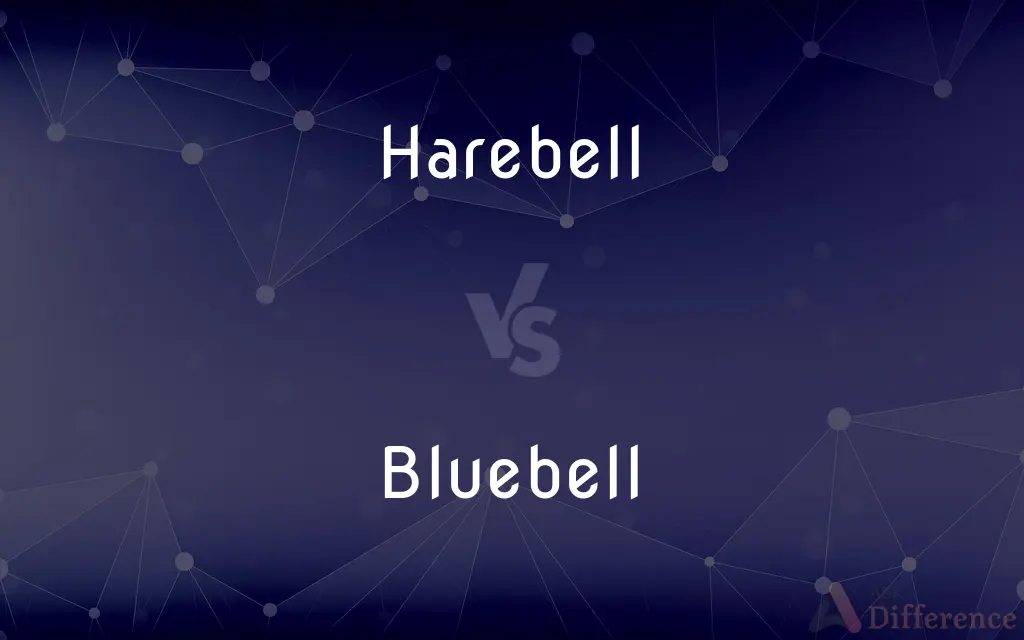Harebell vs. Bluebell — What's the Difference?
By Fiza Rafique & Urooj Arif — Updated on April 18, 2024
Harebell features delicate, bell-shaped flowers on slender stems, thriving in dry, open areas, whereas Bluebell is known for its robust, drooping clusters of blue flowers, often carpeting woodland floors.

Difference Between Harebell and Bluebell
Table of Contents
ADVERTISEMENT
Key Differences
Harebell, also known as Campanula rotundifolia, is characterized by its light, airy growth habit and slender, flexible stems. On the other hand, Bluebell, typically the Hyacinthoides non-scripta, presents with a sturdier stem and dense clusters of bell-shaped flowers.
Harebells produce individual flowers per stem, giving them a sparse yet graceful appearance. Whereas Bluebells grow in clusters, creating a striking visual impact with their deep blue to violet flowers.
The habitat of the Harebell is typically dry, open fields and meadows, preferring well-drained soils. In contrast, Bluebells are synonymous with moist, shaded woodland environments, thriving in richer, damper soils.
Flowering time for Harebells extends from late spring through autumn, providing a prolonged period of bloom. Bluebells, however, have a more concentrated blooming period, typically in the spring, carpeting forest floors for a few weeks.
Harebells are widespread across the northern hemisphere, indicating their adaptability to various climates. Bluebells are more localized, particularly abundant in Western Europe, and are often considered a quintessential sign of ancient woodlands.
ADVERTISEMENT
Comparison Chart
Scientific Name
Campanula rotundifolia
Hyacinthoides non-scripta
Flower Structure
Delicate, single flowers on slender stems
Dense clusters of drooping flowers
Habitat
Dry open fields and meadows
Moist, shaded woodlands
Soil Preference
Well-drained
Damp, rich
Bloom Duration
Late spring to autumn
Concentrated in spring
Compare with Definitions
Harebell
A perennial wildflower with delicate blue bell-shaped flowers.
The meadow was dotted with the subtle blue of harebells.
Bluebell
A bulbous perennial plant known for its vibrant blue, bell-shaped flowers.
The ancient woodland was carpeted with bluebells in spring.
Harebell
Features a thin, wiry stem that sways gently in the breeze.
The gentle breeze made the harebells sway back and forth.
Bluebell
Prefers shady and moist environments, typical in woodlands.
Bluebells flourish under the dense canopy of oak trees.
Harebell
Known for its resilience and ability to grow in lean, rocky soils.
Harebells thrive on the rocky hillside where few other plants can.
Bluebell
A symbol of loyalty and constancy in the language of flowers.
Bluebells are often used in literature to symbolize steadfastness.
Harebell
Commonly found in highland and northern temperate regions.
During our hike, we spotted harebells near the mountain's summit.
Bluebell
Protected in the UK due to its iconic status and declining habitats.
Due to their beauty and rarity, bluebells are protected by conservation laws in the UK.
Harebell
Often associated with folklore and is sometimes called "witch's thimble."
In folklore, harebells are often woven into tales of magic and mystery.
Bluebell
Grows in dense clusters, often creating a blue carpet in forests.
Each spring, the forest floor is transformed by a carpet of bluebells.
Harebell
A perennial plant (Campanula rotundifolia) having slender stems, dense clusters of basal leaves, and bell-shaped blue or white flowers. Also called bluebell.
Bluebell
Any of several bulbous plants of the genus Hyacinthoides, native to western Europe and northwest Africa and having racemes of usually blue to pink bell-shaped flowers.
Harebell
A perennial flowering plant, Campanula rotundifolia, native to the Northern Hemisphere, with blue, bell-like flowers.
Bluebell
Any of various plants of the genus Mertensia, native to Asia, Europe, and North America and having blue, trumpet-shaped flowers.
Harebell
A small, slender, branching plant (Campanula rotundifolia), having blue bell-shaped flowers; also, Scilla nutans, which has similar flowers; - called also bluebell.
E'en the light harebell raised its head.
Bluebell
See harebell.
Harebell
Sometimes placed in genus Scilla
Bluebell
Any of several other plants having bluish, usually bell-shaped flowers.
Harebell
Perennial of northern hemisphere with slender stems and bell-shaped blue flowers
Bluebell
Various flowering plants with blue, usually pendulous, flowers.
Bluebell
In genus Hyacinthoides
Bluebell
In other genera
Bluebell
A plant of the genus Campanula, especially the Campanula rotundifolia, which bears blue bell-shaped flowers; the harebell.
Bluebell
Sometimes placed in genus Scilla
Bluebell
One of the most handsome prairie wildflowers laving large erect bell-shaped bluish flowers; of moist places in prairies and fields from eastern Colorado and Nebraska south to New Mexico and Texas
Bluebell
Perennial of northern hemisphere with slender stems and bell-shaped blue flowers
Common Curiosities
What are the main differences in the growth environment between harebells and bluebells?
Harebells prefer dry, open areas and well-drained soils, while bluebells thrive in moist, shaded woodlands.
Are bluebells protected in any regions?
Yes, in the UK, bluebells are protected due to their iconic status and the decline in suitable woodland habitats.
Do harebells have any cultural significance?
Yes, harebells are often associated with folklore and magic, historically used in tales and myths.
Can harebells tolerate partial shade?
While harebells can tolerate some shade, they thrive best in full sun.
Can harebells and bluebells be planted together in a garden?
Planting them together is challenging due to their differing soil and light requirements.
Which flower blooms for a longer period, harebell or bluebell?
Harebell has a longer blooming period, from late spring to autumn, compared to the brief spring bloom of bluebells.
How do harebells and bluebells reproduce?
Harebells reproduce both by seed and occasionally vegetatively, whereas bluebells primarily reproduce through their bulbs.
What is the typical height of harebells and bluebells?
Harebells are generally around 15-60 cm tall, while bluebells can reach up to 50 cm.
Is it true that bluebells are an indicator of ancient woodlands?
Yes, a dense carpet of bluebells is often an indicator of ancient woodlands, which have been undisturbed for hundreds of years.
How are bluebells and harebells used in landscaping?
Harebells are excellent for rock gardens or dry, sunny areas, while bluebells are ideal for woodland gardens.
Are harebells edible or medicinal?
Harebells are not commonly used for culinary or medicinal purposes.
What are common threats to harebells?
Habitat loss and grazing are significant threats to harebells in many regions.
Which flower is better for attracting wildlife?
Bluebells are particularly good at attracting bees and other pollinators during their blooming period.
What is the best time to plant bluebells for optimal growth?
Planting bluebell bulbs in autumn allows them to establish over the winter and bloom in spring.
Can bluebells and harebells be found worldwide?
Harebells are found widely across the northern hemisphere, while bluebells are predominantly found in Western Europe.
Share Your Discovery

Previous Comparison
Flaccid vs. Plasmolysed
Next Comparison
Muscle vs. OrganAuthor Spotlight
Written by
Fiza RafiqueFiza Rafique is a skilled content writer at AskDifference.com, where she meticulously refines and enhances written pieces. Drawing from her vast editorial expertise, Fiza ensures clarity, accuracy, and precision in every article. Passionate about language, she continually seeks to elevate the quality of content for readers worldwide.
Co-written by
Urooj ArifUrooj is a skilled content writer at Ask Difference, known for her exceptional ability to simplify complex topics into engaging and informative content. With a passion for research and a flair for clear, concise writing, she consistently delivers articles that resonate with our diverse audience.














































